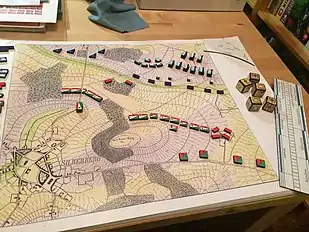Monster game
A monster game is a game that is either very large, or very complex or both.[1] Another criterion adopted is the number of pieces, for example above 1000 counters.[2] This classification can be applied to any board game, but commonly refers to wargames with much playing time. There is controversy over which would have been the first monster game in the field of wargames with many stating that Drang Nach Osten! (GDW, 1973) was pretty universally accepted as the first monster wargame. Drag Nach Osten and his companion, Unentschieden led to the Europa Series games, a giant WWII game.[3]
| Part of a series on: |
| Wargames |
|---|
 |
Wargames that are considered monster games include:
| Wargame | Company | Year | Counters | Playing time (hours) | Description |
|---|---|---|---|---|---|
| Drang nach Osten! (DNO) | GDW | 1973 | 1,792 | 200 | A game to cover Operation Barbarossa, the German invasion of Russia.[4] |
| Europa series | GDW, GRD, Mill Creek Ventures and Historical Military Services (HMS) | 1973- | A series containing 17 war games (the first being Drang nach Osten!), Which can be combined, most games classified as monster games. | ||
| La Bataille de la Moscowa | GDW | 1975 | 1,440 | 16 | A simulation game of the Battle of Borodino. It is both complex and large.[1] |
| War in Europe | SPI | 1976 | 3,600 | 6 | A simulation game of the war in Europe. This game is a combination of War in the East and War in the West with additional rules and mechanics.[5] |
| Highway to the Reich | SPI | 1976 | 2,400 | 6 | The game is set during the Second World War, covering ten days of Operation Market-Garden, from 17 to 26 September 1944, with two hours per turn. |
| War in the Pacific | SPI | 1978 | 3,200 | 6 | A simulation game of the War in the Pacific with 7 maps.[6] |
| The Campaign for North Africa | SPI | 1979 | 1,600 | 1,000 | A game about the Campaign for North Africa |
| The Great War in Europe | XTR Corp | 1995 | 1,200 | 6 | A simulation game of the first world war in Europe. |
| DAK | The Gamers | 1997 | 1,540 | 6 | A game that covers the entire North African campaign at the regimental level |
| Case Blue | The Gamers | 2007 | 3,500 (2,660 unit counters and 840 marker counters) | 375 | A game that covers both the Axis advance (between 1941 and 1942) as well as the Soviet counterattacks (Nov 42 to Jan 43) and the German counteroffensive at Kharkov (Feb-March 1943) including the Case Blue 1942 strategic summer offensive in southern Russia between 28 June and 24 November 1942, during World War II.[7] |
See also
References
- Palmer, Nicholas (1980). "Chapter 3 - The First Thousand Hours are the Hardest: Monster Games". The Best of Board Wargaming. New York, N. Y.: Hippocrene Books. ISBN 0-88254-525-6.
- Palmer, Nicholas (1980). The Comprehensive Guide to Board Wargaming. London: Sphere Books.
- the Staff of Strategy & Tactics Magazine (1977). Wargame Design: The History, Production and Use of Conflict Simulation Games. New York: Simulations Pubublications, Incorporated. ISBN 0-917852-01-X.
- Freeman J, The Editors of Consumer Guide (1980). The Complete Book of Wargames. New York: Simon and Schuster. ISBN 0-671-25374-3..
- Dunnigan, James (1992). The Complete Wargames Handbook. New York: Quill. ISBN 0-688-10368-5..
- Perla, Pewter P. (1990). The Art of Wargaming. Annapolis, Maryland: Naval Institute Press. ISBN 0-87021-050-5..
- "Case Blue (2007)". Boardgamegeek. Retrieved 2017-12-28.
External links
- Drang Nach Osten! (Boardgamegeek)
- SPI Monster Games
This article is issued from Wikipedia. The text is licensed under Creative Commons - Attribution - Sharealike. Additional terms may apply for the media files.
